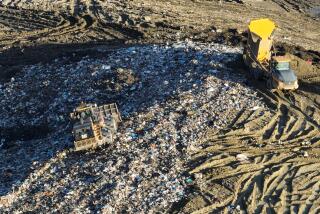Editorial: Five years after the Aliso Canyon methane leak, California is still too reliant on fossil fuels
Five years ago, a broken well in the Aliso Canyon underground natural gas storage field in Porter Ranch caused the largest leak of methane in U.S. history.
The leak forced more than 8,000 families to temporarily flee their homes because of the sickening smell. Over four months, the facility released more than 100,000 metric tons of methane — a potent greenhouse gas. The effects of the leak were equivalent to the carbon dioxide emissions released from burning over 1 billion gallons of gasoline.
The Aliso Canyon leak was an environmental catastrophe on the scale of the Deepwater Horizon oil spill in the Gulf of Mexico in 2010. Like that earlier disaster, the Aliso Canyon blowout forced a reckoning with the risks and consequences of relying on fossil fuels. And it prompted leaders to call for the eventual shutdown of the Aliso Canyon underground storage field, something that would be feasible only if the state reduced its dependence on natural gas.
If there can be a silver lining to an environmental disaster, it would be that the blowout spurred innovation and aggressive new renewable energy targets. The Los Angeles City Council began studying the transition to 100% renewable energy and committed to phase out three natural-gas-fueled power plants in the region. Plus, the temporary closure of Aliso Canyon prompted Southern California Edison and San Diego Gas & Electric to invest in their first battery-based storage facilities. That helped prove the viability of using batteries to store excess power, which will be essential as California increases the use of intermittent sources of renewable energy such as wind and solar.
But other ambitious efforts to reduce the region’s reliance on natural gas and, thus, on facilities like Aliso Canyon have stalled — or haven’t even gotten off the ground.
In 2017, then-Gov. Jerry Brown’s administration said Aliso Canyon’s natural gas storage would be phased out in a decade. But the planning moved at a glacial pace. Gov. Gavin Newsom announced last year that he wanted to fast-track the shutdown and directed the new California Public Utilities Commission president to expedite planning for the facility’s closure.
The commission, however, is analyzing what it will take to close Aliso Canyon no sooner than 2027 — or as late as 2035, a decade before California is supposed to transition to 100% clean power. It’s clear that the state’s energy overseers are reluctant to give up Aliso Canyon’s gas storage capacity, which they say helps keep prices lower and supplies steady during cold snaps and heat waves. But continuing to rely on fossil fuels conflicts with California’s climate goals and the state’s desperate need to slow global warming, which is worsening fire seasons, droughts and other impacts.
There’s reluctance, and obstruction, in other policy areas too. About a quarter of Southern California Gas Co.’s supply goes to residential customers, so reducing or eliminating natural gas use in homes would help reduce reliance on Aliso Canyon. But there’s been little political will to enact building codes that require new homes to be equipped for all-electric appliances. Roughly 30 cities in California have passed building electrification laws, and just one — Santa Monica — is in Los Angeles County.
California has already committed to decarbonizing its energy system in the coming decades. Why continue to construct homes and offices that rely on natural gas? It will cost residents far more in the future to retrofit homes for all-electric systems.
There’s no reason that Newsom — who recently pledged that the state would bar the sale of gasoline-fueled cars after 2035 — can’t also issue an executive order to phase out gas appliances in new homes. Likewise, the California Energy Commission is due to update the state’s building energy code next year. The commission in 2018 required solar panels on new homes; it makes sense to also require new homes to be all-electric to take advantage of those panels.
None of these are easy changes, practically or politically, but they are essential for cleaner, healthier communities and the planet. The Aliso Canyon leak was a wake-up call about the dangers of fossil fuels. In the five years since, as the climate has become hotter and droughts, fires and flooding more intense, it’s become even more apparent that California has to move much faster to change the way we create and consume energy.
More to Read
A cure for the common opinion
Get thought-provoking perspectives with our weekly newsletter.
You may occasionally receive promotional content from the Los Angeles Times.










